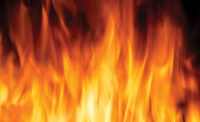• Jon, a journeyman electrician, was taking data on circuit breakers that he believed to be deenergized. While closing one of the enclosure doors, an arc flash occurred. The arc flash blew the door open, knocking him back against a wall and causing him to lose consciousness in front of the enclosure, which continued to arc. Don, a journeyman electrician, was Jon’s working partner that day. Although not initially injured by the arc flash, Don was burned as he rescued an unconscious Jon from in front of the enclosure as it continued to arc.
— From the CDC (Centers for Disease Control and Prevention) publication Arc Flash Awareness: Information and Discussion Topics for Electrical Workers
• A 30-year-old male electrical technician was helping a company service representative test the voltage-regulating unit on a new rolling mill. While the electrical technician went to get the equipment service manual, the service representative opened the panel cover of the voltage regulator’s control cabinet in preparation to trace the low-voltage wiring in question (the wiring was not color-coded). The service representative climbed onto a nearby cabinet in order to view the wires. The technician returned and began working inside the control cabinet, near exposed, energized electrical conductors. The technician tugged at the low-voltage wires while the service representative tried to identify them from above. Suddenly, the representative heard the victim making a gurgling sound and looked down to see the victim shaking as though he were being shocked. Cardiopulmonary resuscitation (CPR) was administered to the victim about 10 minutes later. He was pronounced dead almost two hours later as a result of his contact with an energized electrical conductor.
— From the CDC (Centers for Disease Control and Prevention) publication Electrical Safety: Safety and Health for Electrical Trades, Student Manual, Revised Edition
• An electrical foreman with more than 20 years’ experience was working on a high-voltage circuit that he thought was de-energized. Unfortunately, he had de-energized the wrong circuit. He was thrown back by an arc flash/blast and received burns to his arm, neck, and face.
• A journeyman lineman was holding an energized 2,200-volt wire when it grounded out through his leg. He sustained electric shock burns to his trunk and leg and associated flash burns to his hands.
— From Report # 86-1-2006, Burn Injury Facts, Arc Flash/Blast, developed by the Safety & Health Assessment & Research for Prevention (SHARP) Program at the Washington State Department of Labor and Industries
A quick search of the Internet reveals dozens of stories of workers injured in arc flash and electrical-related incidents. But these incidents and injuries can be prevented if workers take precautions, use proper equipment, wear the appropriate personal protective equipment and follow pertinent regulations.




